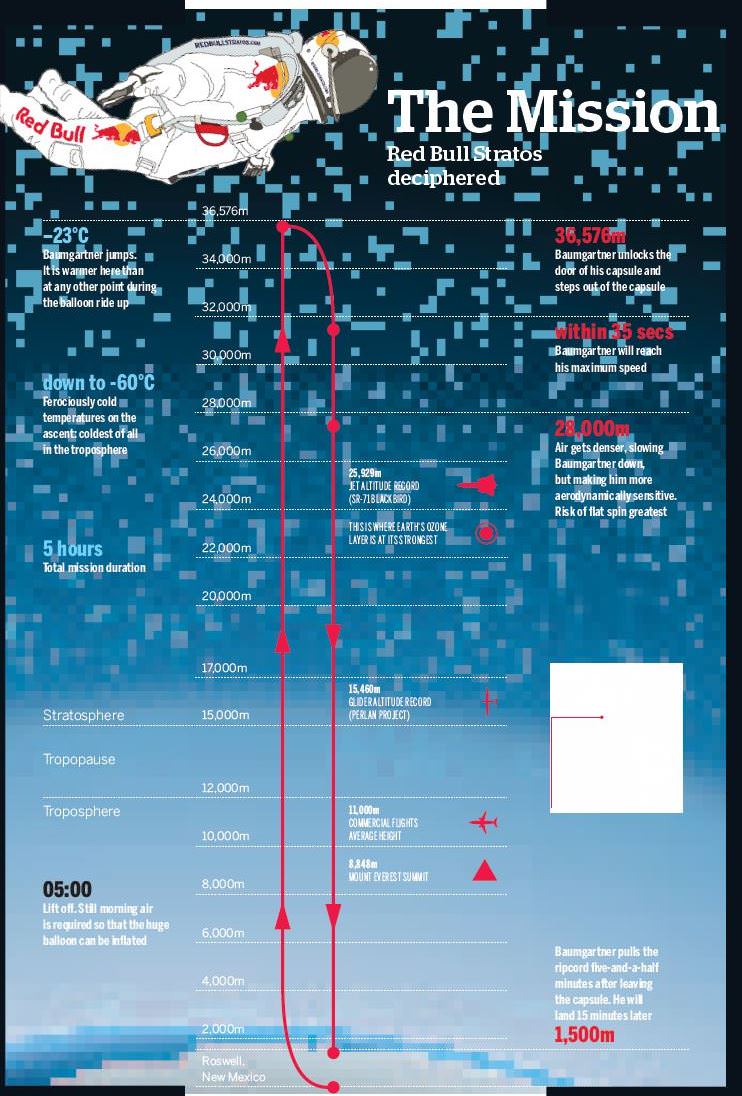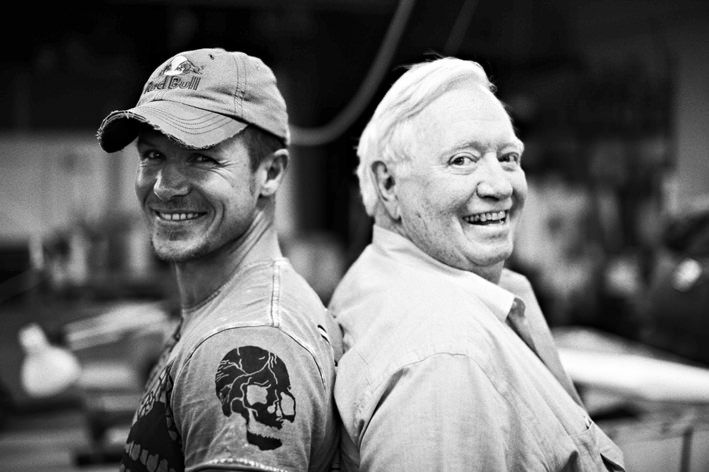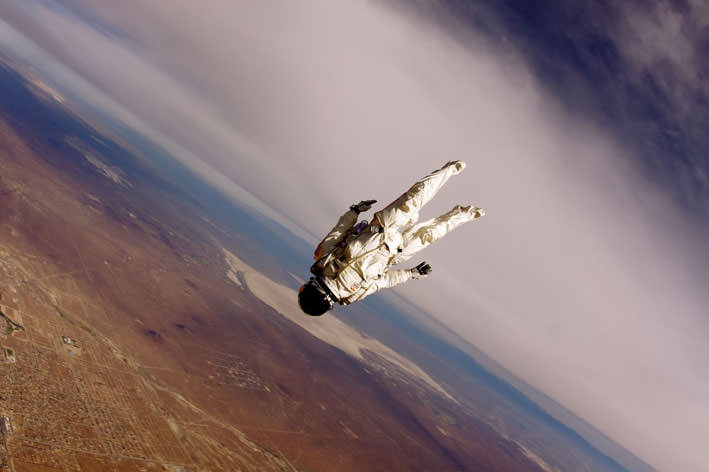In preparation for his jump from from 36,500 meters (120,000 feet) sometime this summer, Austrian skydiver Felix Baumgartner took a practice jump yesterday from Roswell, New Mexico. The Red Bull Stratos Mission just posted the video of the jump — well, actually everything but the jump (you’ll see the preparations and post landing in this video). I’m sure the best footage is being saved for a documentary about the mission that is being done by the BBC and National Geographic. But this taste of the action whets your whistle for the big jump, when Baumgartner could become the first person to go supersonic outside a vehicle. He plans one more test jump, from 27,400 meters (90,000 feet) before attempting the full 36,500 meters to break the record for the longest freefall. According to Red Bull Stratos, the ‘launch window’ for the big jump opens in July and extends until the beginning of October.
Skydiver Baumgartner Takes Test Jump from 21,000 Meters
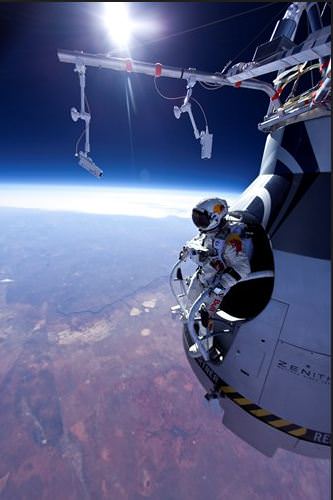
[/caption]
Austrian skydiver Felix Baumgartner took a practice jump today, (March 15, 2012) to help him prepare for his leap from the edge of space later this year where he hopes to not only break the sound barrier with his body, but also break the record for the longest freefall. In preparation for his Red Bull Stratos mission, Baumgartner rode his specially-made pressurized capsule via a helium balloon and jumped from an altitude of 21,818 meters (71,581 feet, 21 kilometers, 13.5 miles) from the skies near Roswell, New Mexico.
“Felix can consider himself part of a very exclusive club today,” said a spokesperson from the Red Bull Stratos mission, “joining Joe Kittinger and Eugene Andreev (USSR) all who have jumped from above 70,000 feet.”
42-year-old Baumgartner is hoping to jump from 36,500 meters (120,000 feet) this summer, to break the current jump record held by Kittinger a retired Air Force officer, who jumped from 31,500 m (31.5 km, 19.5 miles) in 1960.
Today, Baumgartner’s freefall lasted 3 minutes 43 seconds, reaching a top speed of 586 kph (364 mph). Baumgartner deployed his parachute at 2,405 m (7,890 feet), by far the highest jump he has ever made, said Red Bull officials. And he was taken back by the difference: “I thought that I had to pull the parachute, then I looked at the altitude and realized that I’m still at 50,000 feet,” Baumgartner said in a press release.
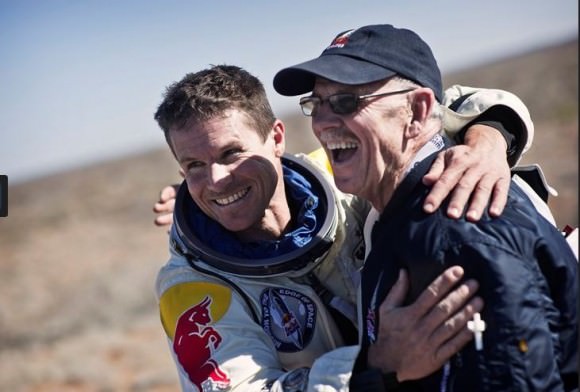
Officials said he was “super jazzed” about the jump today, saying “I can’t wait to stand on that step. I can’t wait!”
Today’s test was the first “manned” capsule flight lifted by a high-altitude balloon. Baumgartner flew above a life-critical zone known as the Armstrong Line, all the way to an estimated 21,818 meters. Above 18,900 meters (62,000 feet) is not survivable without a pressure suit, and at that height, Baumgartner also experienced the coldest part of the atmosphere with temperatures as low as -70 C (-94F).
Baumgartner said later the most difficult part was the extreme cold he encountered. “I could hardly move my hands,” he said. “We’re going to have to do some work on that aspect.”
Reportedly Kittinger, now 83 and who is on the team assisting in the mission, sent Baumbartner a message before he jumped: “Felix, you’re going to have one heck of a view when you step out of that door… enjoy the experience.”
Baumgartner landed safely in an open field just to the east of Roswell, New Mexico. “This test serves as the perfect motivation for the team for the next step,” said Baumgartner after he touched down, referring to his upcoming record-breaking jump attempt.
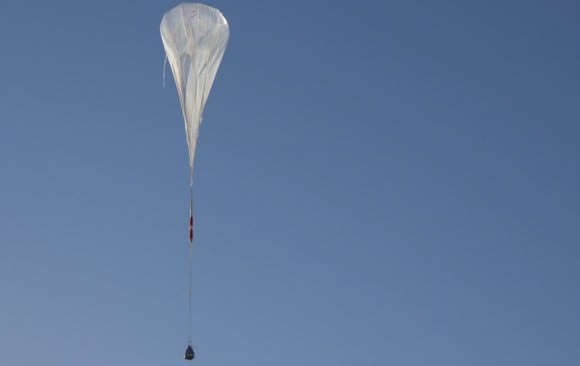
For more info see the Red Bull Stratos website.
Capsule and Skydiver Ready for Record-Setting Freefall
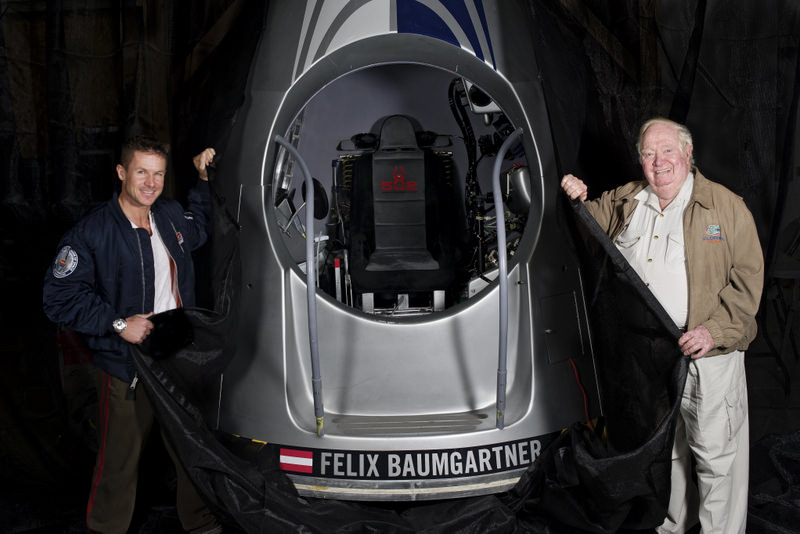
[/caption]
Part science experiment, part publicity stunt, part life-long ambition, the Red Bull Stratos mission will feature skydiver Felix Baumgartner attempting to break the speed of sound with his body in a record-setting freefall from the edge of space. The team has been working for over 5 years to build the high-tech capsule that will bring Baumgartner to 36,500 meters (120,000 feet) above Earth, via a stratospheric balloon, and Red Bull Stratos has now released a few images of the capsule. The craft weighs 2,900 pounds fully loaded and it will act as Baumgartner’s life support system during his nearly three-hour ascent. Here’s the outside of the capsule, with Baumgarter standing by, along with the current record holder for such a jump, Joe Kittinger, who jumped from 31,333 meters (102,800 feet) in 1960.
Take a look inside the capsule:
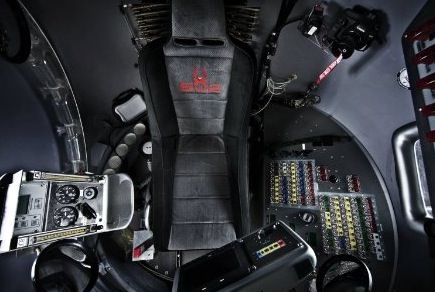
The pressurized area inside the capsule has of less than 2 meters (6 feet) and contains the flight control panel with 89 different switches and various instrumentation, and a custom-made chair custom to fit Baumgartner and his space suit. It is molded from fiberglass and epoxy, while the door and windows are made of acrylic. The pressure sphere’s interior will be pressurized to 8 pounds per square inch (psi), the equivalent of 16,000 feet above sea level, to reduce the risk of decompression sickness during the ascent without requiring Felix to inflate his pressure suit.
The clear door will give Baumgartner the best view in the stratosphere, but it also puts just half an inch of acrylic between him and the edge of space.
A Chrome-Moly cage and an external foam-insulated shell surrounds the capsule, making it 3.3 meters high (11 feet) and 2.4 meters (8 feet) in diameter at its base.
According to Red Bull Stratos, the capsule will be suspended 45 meters (150 feet) below the balloon, and will protect Baumgartner from stratospheric temperatures reaching minus -55 C (-70 Fahrenheit), providing a pressurized environment during the ascent, with air to breathe so he can avoid decompression sickness. He will inflate his pressure suit only as he prepares to exit the capsule.
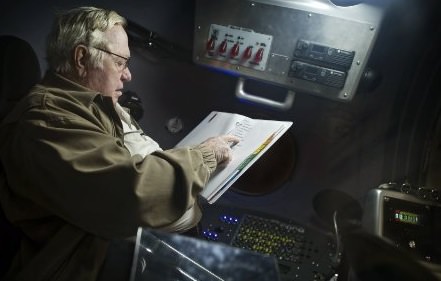
When Kittinger made his jump, he used a gondola instead of the sealed capsule that Baumgartner will use. Red Bull Stratos says that the additional altitude for this mission means that there are exponentially greater hazards from exposure to freezing temperatures, oxygen deprivation and low air pressure, and the capsule is designed to protect him from that.
The science team collaborated with aerospace engineers to overcome the challenges that the hostile environment of the stratosphere presents to the electronics, radio communications and camera systems vital to the capsule’s operation. They also wanted to build a vessel capable of capturing valuable scientific data as well, to help advance aerospace research. The capsule was designed and hand-constructed at Sage Cheshire Aerospace, Inc. in Lancaster, California.
Once the capsule has completed its ascent and Baumgartner has safely accomplished his mission, a remote triggering system will release the craft from the balloon. Tracked via a GPS system, a recovery parachute will bring the capsule slowly back to Earth, where the data can be extracted and evaluated.
The base of the capsule has a 5 cm (2-inch) thick aluminum honeycomb panel which protects the capsule from sharp objects during landing and provides a mounting for the balloon system control box and batteries. Attached to the base are the landing crush pads, made of a cell-paper honeycomb covered by a fiberglass/epoxy fairing. They are designed to handle as much as 8 Gs on impact. Taking more than 150 drop tests to develop, the crush pads can be used only once and must be replaced after every flight.
The capsule has been thoroughly tested, and the Red Bull Stratos team says they are ready to fly. An exact date for the jump has not been released, but sources say it will likely be in August or September 2012.
More info:
Red Bull Stratos website
Infographic: The Anatomy of a Supersonic Freefall
What are all the steps and stages of Felix Baumgartner’s record-setting freefall attempt which will take place later this year? This infographic provides a look at what happen during the jump.
More info see our article about Baumgartner and the Red Bull Stratos mission, or the Red Bulletin. Alan Boyle’s Cosmic log has a different version of this infographic, a larger (12MB) pdf.
Skydiver Prepares for Record-Setting Freefall from the Edge of Space
In 2010, we reported on Felix Baumgartner and his upcoming attempt to break the sound barrier with his body, in a freefall from the edge of space. Part science experiment, part publicity stunt, part life-long ambition, the Red Bull Stratos mission will have Baumgartner traveling inside a capsule with a stratospheric balloon to 36,500 meters (120,000 feet), where he will step out and attempt a record-setting highest freefall jump ever. The mission was delayed by two years by a lawsuit, but Baumgartner’s jump is now back on, and will be attempted later this year, perhaps late summer or early fall 2012.
If Baumgartner is successful, the mission will break four world records: the altitude record for freefall, the distance record for longest freefall, the speed record for fastest freefall by breaking the speed of sound with the human body, and the altitude record for the highest manned balloon flight.
“This is the biggest goal I can dream of,” Baumgartner said. “If we can prove that you can break the speed of sound and stay alive I think that is a benefit for future space exploration.”
Above is a video of some of the preparations to test Baumgarter’s pressure suit and his body’s reaction to what he will endure during the freefall. The pressurized “space” suit and helmet supplies 20 minutes of oxygen includes especially designed equipment developed to capture data throughout the mission for the medical and scientific advancement of human flight.
The speed of sound — historically called the ‘sound barrier’ – has been broken by rockets, various jet-powered aircraft and rocket-boosted land vehicles. No one has broken it yet with just their body.
[/caption]
Back in 1960, a US Air Force captain named Joe Kittinger made aerospace history by making a jump from 31,000 meters (102,800 feet) in what was called project Excelsior. His jump contributed valuable data that provided ground work for spacesuit technology and knowledge about human physiology for the US space program. There have been several attempts to surpass Kittinger’s record, but none have succeeded, and people have given their lives for the quest.
Kittinger has been working with Baumgartner to help him prepare for the jump.
The Red Bull Stratos mission is named after the energy drink company that is sponsoring the jump by the renowned Austrian skydiver. Red Bull Stratos team members say the mission will explore the limits of the human body in one of the most hostile environments known to humankind, in the attempt to deliver valuable lessons in human endurance and high-altitude technology.
The lawsuit that halted the jump was made by Daniel Hogan, who claimed he pitched the idea of breaking the 50-year old freefall record to Red Bull in 2004, and that Red Bull said they weren’t interested, but later, the company went forward with the idea. Hogan filed a multi-million dollar lawsuit against the energy drink company, but the two parties settled out of court.
The delay may have been a good thing, however. Baumgartner revealed that in December 2010 during first pressure tests of the suit, he had a panic attack, an event which he called “the worst moment of his life.”
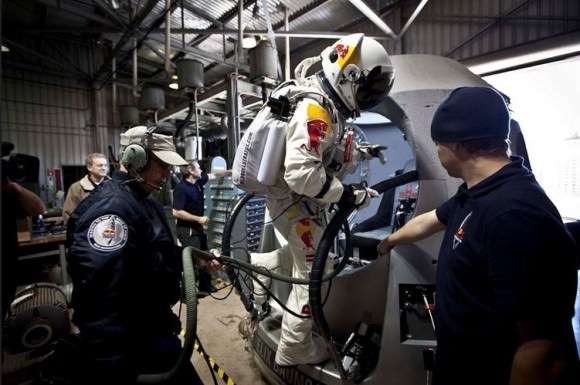
“When it came to the crucial pressure test at -60°C, under real conditions with pressure and altitude simulated, and surrounded by cameras, air force personnel and scientists, I realized I just couldn’t do it,” Baumgarter said in an article in the Red Bulletin.
Baumgartner said he thought the suit should feel like ‘second skin’ but instead he felt like his movements and perceptions were restricted. “As soon as the visor closes there’s this nightmarish silence and loneliness – the suit signifies imprisonment. We hadn’t originally conceived of a test that confined me in the suit for five hours – that’s how long the entire mission should take – with the visor closed. After all my past exploits, all the extreme things I’ve done in my career, no one would have ever guessed that simply wearing a space suit would threaten the mission, me included. In the end, the symptoms developed into panic attacks.”
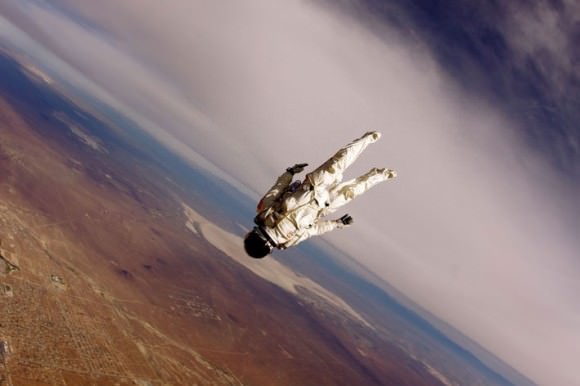
But Baumgarter has been able to overcome the panic attacks and now is moving forward with the preparations for the jump. The jump will be recorded for a documentary with 15 cameras onboard the capsule and three cameras on Baumgarter’s body. The documentary will be produced by the BBC together with the National Geographic channel, with a feature-length film airing on the two channels following the jump.
The mission will take place in Roswell New Mexico because of the favorable conditions. The area is sparsely populated, plus it has some of the world’s best facilities for balloon launches such as this, and the weather allows several good windows for a successful launch.
For more information, see the Red Bull Stratos website, and the Red Bulletin.
Take a look at the infographic about the jump.
Attempt to Break Free-Fall Record Halted by Lawsuit
[/caption]
An attempt to reach supersonic speeds during freefall has hit a snag as a promoter who says the stunt was originally his idea has filed a lawsuit against the Red Bull Stratos team. Daniel Hogan claims he pitched the idea of breaking a 50-year old freefall record to Red Bull in 2004, and that Red Bull said they weren’t interested, but later, the company went forward with the idea. Hogan has filed a multi-million dollar lawsuit against the energy drink company, prompting Red Bull to stand down with the record-breaking attempt until the issue can be resolved.
Red Bull issued this statement today:
“Despite the fact that many other people over the past 50 years have tried to break Colonel (Ret.) Joe Kittinger’s record, and that other individuals have sought to work with Red Bull in an attempt to break his record, Mr. Hogan claims to own certain rights to the project and filed a multimillion dollar lawsuit earlier this year in a Californian court. Red Bull has acted appropriately in its prior dealings with Mr. Hogan, and will demonstrate this as the case progresses. Due to the lawsuit, we have decided to stop the project until this case has been resolved.”
Austrian Skydiver Felix Baumgartner had been scheduled to jump from a balloon at 120,000 feet and attempt a freefall jump that would, for the first time, reach supersonic speeds as well as, Red Bull says, deliver valuable scientific data. If successful, it would break a record set in 1960 by US Air Force captain named Joe Kittinger when he jumped from 31,000 meters (102,800 feet). His jump contributed valuable data that provided ground work for spacesuit technology and knowledge about human physiology for the US space program. There have been several attempts to surpass Kittinger’s record, but none have succeeded, and people have given their lives for the quest.
Kittinger has been supportive of Baumgartner’s attempt and appeared in this video with him.
Hogan says he pitched the idea to Red Bull as a “marriage of daredevil, record-breaking ‘stuntsmanship’ and cutting-edge technology.” After a year of talks, during which Hogan says Red Bull executives encouraged him to reveal the minutest details of the project, the company backed out.
In January this year, Red Bull announced the Red Bull Stratos dive, which Hogan said is precisely the project he pitched except for two things: the name was been changed and he was cut out of it.
Earlier this year, Hogan sought an injunction to halt the project, disgorgement of any profits and punitive damages. He also sought a declaration that Red Bull has certain, specific duties to him.
In his complaint in Los Angeles Superior Court, Hogan claims the daredevil stunt would be worth $375 million to $625 million in advertising to any corporate sponsor.
Hogan claims his proposed dive would be made from 130,000 feet. He also said he had assembled a team that included Per Lindstrand, who holds the hot-air balloon altitude record, Dr. Coy Foster, a former NASA flight surgeon, Dr. Steve Lingard, an expert in the aerodynamics of the human body, filmmaker Slim McDonald, and a Russian company that agreed to develop the spacesuit.
Hogan claims that in meetings, emails and other communications Red Bull received specifications for the gondola to be used, the spacesuit, the timeline for developing and testing the equipment, and a list of potential corporate partners.
But on Oct. 13, 2005, Hogan says the company sent him an email stating that “after a very detailed investigation of your proposal, we finally came to the conclusion that we would not like to continue our joint work on the space Dive project.”
Hogan says Red Bull never acknowledged his idea nor has it offered to compensate him for his contributions or sought permission to use information that he disclosed in confidence.
Sources: Red Bull Stratos, Courthouse News Service
Record-Setting Freefall Attempt Will be Webcast
Want to know what it is like to bail out in near space and freefall 37 km (23 miles) to Earth? You’re about to find out. While no date has been announced yet for Felix Baumgartner’s attempt at breaking the speed of sound during freefall, when it does occur, everyone will be able to watch. The Red Bull Stratos mission team announced today there will be a live television broadcast and online stream of the activities. In-flight cameras will be mounted on the capsule that brings him to 36,500 meters (120,000 feet) altitude via stratospheric balloon, as well as on Baumgartner’s space suit. If successful, this will be the first time in history a freefalling human body will reach supersonic speeds.
[/caption]
There will also be microphones inside the capsule and inside Baumgartner’s helmet. Those on the capsule will record sound only as long as there is air to carry the soundwaves. When Baumgartner depressurizes the capsule (just before he jumps), those ambient microphones in the capsule will stop picking up sound, but his helmet mic should keep working.
The final launch date, location and live stream details will be announced in the coming weeks on www.redbullstratos.com, on Twitter (@RedBullStratos), and on Facebook.
The current record-holder, USAF Col. (Ret.) Joe Kittinger jumped from 102,800 feet 50 years ago this month. He did not break the speed of sound, although he probably came close. There have been several attempts to surpass Kittinger’s record, but none have succeeded, and people have given their lives for the quest. There are some movies and images from Kittinger’s jump, and his team used spring-wound motion picture cameras warmed by hot-water bottles to document his freefall. Red Bull Stratos will use high-definition video cameras and ultra-high-definition 4K digital cinematography cameras. The challenge will be keeping them cool in an environment where the air is too thin to wick away their heat.
The footage is being taken by FlightLine Films, who will be making a documentary about the jump, so it’s not clear how much will be live on the webcast, although the press release by Red Bull Stratos says the camers will “provide viewers of the worldwide broadcast with perspectives of the capsule, the skyscape and Baumgartner himself.”
And of course there is the main reason to record everything that happens in the jump: for the benefit of scientific research.
We’ll provide an update on the date of the Baumgartner’s jump when it is announced.
Read our preview article on Baumgartner’s record-breaking attempt.
Red Bull Stratos Update: Breaking the Speed of Sound in Freefall
[/caption]
Here’s an update on the Red Bull Stratos project, where skydiver Felix Baumgartner will attempt to break the speed of sound during freefall. (Read our preview article). Baumgartner and the project’s aeronautic’s experts recently conducted the latest round of high-altitude test jumps and step-off procedure tests. Baumgartner himself reports feeling both satisfaction and apprehension while the team prepares to move into a new phase of testing.
During the last week in May 2010, the Red Bull Stratos team conducted three important tests. In the capsule step-off test, conducted at Sage Cheshire Aerospace in Lancaster, California, the capsule dangled from a 40,000-ton crane to simulate its suspension from the balloon flight train, with Baumgartner practicing his movements inside, exiting and stepping off. The purpose was to determine how the vessel reacts to Baumgartner’s motion, and whether those reactions could compromise his descent. Even a relatively gentle tumble created by imprecise step-off could not only hinder Baumgartner’s ability to break the sound barrier but also suddenly devolve into a dangerously rapid “flat spin” once he encounters a level of increased air density.
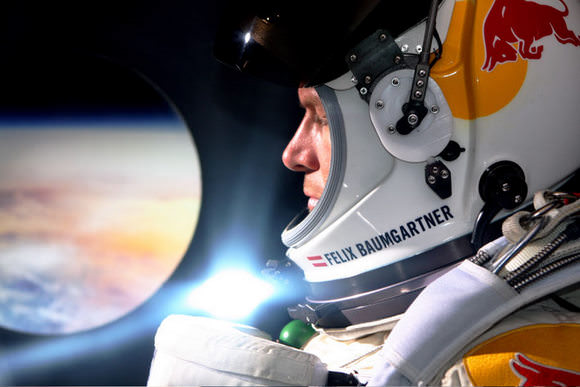
Next, a group of pre-eminent aerospace experts and test pilots – including Joe Kittinger, who holds the records Baumgartner will try to break – gathered in a deserted Palmdale fairground to witness something they’d never seen during all their combined years of experience: a bungee jump in a pressurized space suit and helmet. After multiple jumps from a crane basket suspended 200 feet above the ground, Baumgartner’s exit technique had evolved into something that one team member described as “perfect.”
The finale to the week of testing was a series of skydives over the desert in Perris, California, reaching approximately 26,000 feet. This test, conducted on May 27, 2010, was the first in a fully pressurized suit and was a follow-up to a similar day of flights in early spring. Baumgartner had been frustrated by the awkwardness of his equipment, especially by the way his chest pack – a vital technology hub for the descent – jammed his helmet and inhibited movement on descent and blocked his vision while landing. Objectives were to get a clean step-off from the rear-exit airplane; assess controllability and various body positions in the fully pressurized suit; experience suit deflation upon descent; and test a new chest pack system that allows one side to move out of Baumgartner’s line of sight so he can spot his landing. Baumgartner’s technique and the improved equipment worked so quite well, so the team was able to accomplish all objectives.
Source: Red Bull Stratos
Skydiver Hopes to Break the Speed of Sound in Freefall
[/caption]
The speed of sound — historically called the ‘sound barrier’ – has been broken by rockets, various jet-powered aircraft and rocket-boosted land vehicles. Felix Baumgartner wants to break the sound barrier with his body, in freefall from the edge of space. He will travel inside a capsule with a stratospheric balloon to 36,500 meters (120,000 feet) step out and attempt a freefall jump targeted to reach – for the first time in history – supersonic speeds.
“After years of training with my team of dedicated Red Bull Stratos experts, I’ll be going on a journey that no one has ever done,” Baumgartner told Universe Today in an email message. “If I succeed, I will be the first person to break the sound barrier, alone. That will be a record for all eternity. As such, a piece of me will become immortal. That excites me.”
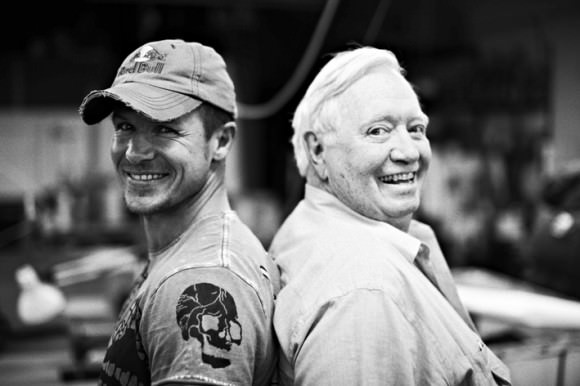
Back in 1960, a US Air Force captain named Joe Kittinger made aerospace history by making a jump from 31,000 meters (102,800 feet). His jump contributed valuable data that provided ground work for spacesuit technology and knowledge about human physiology for the US space program. There have been several attempts to surpass Kittinger’s record, but none have succeeded, and people have given their lives for the quest.
Sometime during 2010, Baumgartner will make an attempt in his “Red Bull Stratos” mission — named after the energy drink company that co-created the program with the Austrian skydiver. Red Bull Stratos team members say the mission will explore the limits of the human body in one of the most hostile environments known to humankind, in the attempt to deliver valuable lessons in human endurance and high-altitude technology.
“This is the biggest goal I can dream of,” Baumgartner said. “If we can prove that you can break the speed of sound and stay alive I think that is a benefit for future space exploration.”
If Baumgartner is successful, the Red Bull Stratos mission will break four world records: the altitude record for freefall, the distance record for longest freefall, the speed record for fastest freefall by breaking the speed of sound with the human body, and the altitude record for the highest manned balloon flight.

How fast will Baumgarter need to go to beat the speed of sound? Sound travels at different speeds through the atmosphere (as well as through different mediums), depending on atmospheric density and temperature. For example, at sea level, in average conditions of about 15 degrees C (59 degrees F), sound travels at around 1,223 kph (760 mph). But at higher altitudes, where the air is colder, sound travels more slowly.
Researchers with the Red Bull Stratos mission anticipate Baumgartner could break the sound barrier at about 30,480 meters (100,000 feet) above sea level, in temperatures of -23 to -40 C (-10 to -40 F) where sound travels at about 1,110 kph (690 mph) or roughly 304 meters per second (1,000 feet per second).
So, he’ll have to go faster than those speeds – or Mach 1 — to be supersonic.
While there is no literal “barrier,”the transition to supersonic speeds can cause problems for aircraft as transonic air movement creates disruptive shock waves and turbulence. Data obtained from Chuck Yeager’s first supersonic flight in 1947 allowed for changes in design of supersonic aircraft to avoid problems. Still, some aircraft still experience problems, and going supersonic has been attributed to some air disasters.
And the human body isn’t designed for supersonic speeds.
“Our biggest concern is that we don’t know how a human unencumbered by aircraft is going to transition through this,” said the project’s Medical Director Dr. Jonathan Clark, a flight surgeon for six space shuttle missions (and husband of astronaut Laurel Clark who died in the Columbia disaster in 2003), who has researched numerous aerospace disasters. “But it’s also exactly what we’re hoping to learn, for the benefit of future space flights.”
Documents provided by the Red Bull Stratos mission say that the data obtained from the mission will be shared with the scientific community, and Clark notes that he expects long-awaited medical protocols to be established as a result.
At the low temperatures and tenuous atmospheric conditions that Baumgartner will experience, he could suffer from hypothermia, the bends –if he gains altitude too fast during ascent –, or he could experience ebullism – the infamous condition where gas bubbles can form in the blood, and the blood basically “boils.”
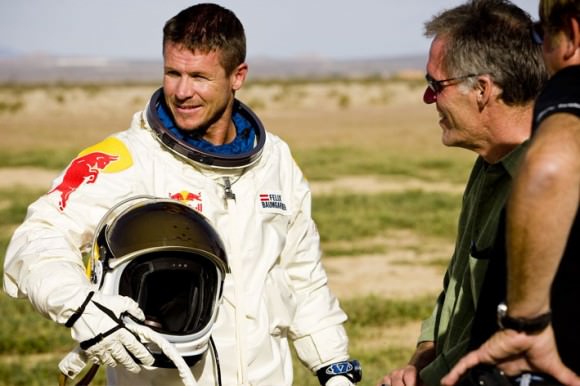
That’s why his spacesuit is so important.
“I have absolute confidence the suit is going to work,” said Daniel McCarter, Program Manager for the David Clark Company, the same company that made Kittinger’s suit back in 1960, as well as full pressure suits for NASA astronauts and military pilots flying in aircraft that can reach the edge of the atmosphere. “Every time someone jumps a suit system like this there is something to learn. We learn knowledge for future systems.”
Art Thompson, the mission’s Technical Project Director, added, “We are ultimately risking life. Felix realizes that his life is on the line. Our job is to do everything we can from an engineering and technical point of view to keep him safe.”
The suit Baumgartner will use is custom-made for him, so there should be no pressure points caused by the suit that would make him uncomfortable, but any pressure suit restricts mobility and dexterity. He will have to avoid movements that could cause him to go into an uncontrollable spin.
Baumgartner is not new to jumping. He owns several world records for B.A.S.E. jumping and is well known for skydiving across the English Channel in 2003. He is also a parachutist, stunt coordinator and a commercial helicopter pilot.
“I think I’ve always been one of those guys who wanted to be in the places where no one has been before. It’s inside your body or brain,” Baumgartner said in a video on the Red Bull Stratos website. “When I was a kid, I liked to climb up trees –I always wanted to be on top of something.”
This will definitely be an attempt to go where no one has gone before.
For more information on the mission, visit the Red Bull Stratos website, or Felix Baumgartner’s website.

